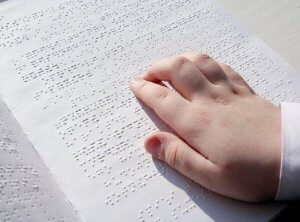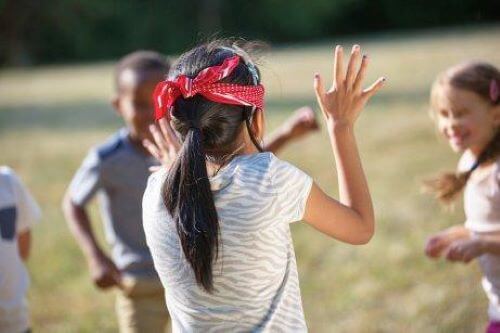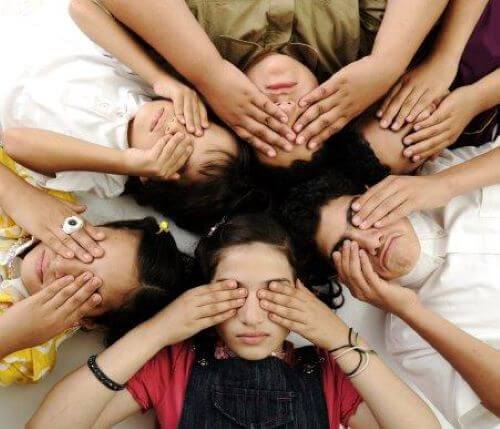Children with Visual Impairments and Classroom Activities

Our society works hard to ensure that children with disabilities – in this case, children with visual impairments – also have ready access to activities they enjoy.
Playing with other children is one of the most important activities in children’s lives as they grow up. For this reason, here you’ll find a series of activities that can include children with visual impairments.
Visual impairments in children
According to the World Health Organization, there are four different levels that classify the quality of our vision:
- Normal vision
- Moderate vision impairment
- Serious vision impairment
- Blindness
Within these four categories, people also commonly refer to the following three subgroups as well: normal vision, moderate or serious impairment, and blindness.
Activities for children with visual impairments
Children with visual impairments develop better motor skills and are more adept at using their other senses.
It’s important, especially in the classroom, that activities for children with visual impairments are inclusive. That is to say, teachers need to plan activities that can be carried out with all the children.
This has a series of advantages for all the children in the classroom:
- The children with disabilities won’t feel inferior to their classmates, rather they’ll feel they’re equal. This aspect is very important for their own mental health.
- The other children will be more conscious of the difficulties that their classmate with a visual impairment faces and they’ll take such matters more seriously.
- All children will develop better motor and sensory abilities with these games, which is very important for children with visual impairments, but also for the benefit of the other children.
Activity: Noah’s Ark
To set up this game, the teacher will look for a wide open space, and place a recorder in a convenient spot where it will be heard by all the children. The recorder will play the sound of an animal or one of the elements (like water, fire, wind…).
The children with normal vision will be blindfolded so they have no advantage over the children with visual impairments. The children will pair off or form into groups depending on how many are involved in the game.

Once everything is in place, the teacher will start playing the sounds on the recorder. The children should listen carefully and move towards where they think the sound is coming from.
If the students hear the sound played and arrive in the right spot, the teacher will give them a drawing of the animal or the element in question. The group that collects the most drawings will win.
This game is useful because the children work as a team and make decisions together. The children have to cooperate and all move towards the same spot together. Moreover, they develop their auditory capabilities and their sense of orientation because they have to listen and guess from where the sound originates from.
They have to move carefully by extending their hands and touching around them so they don’t bump into the other children. They also need the ability to situate themselves using their senses other than sight.
Activity: The secret code
The secret code game is recommended for older children because it can be a little more complex. In a wide open space, the teacher will assemble a little obstacle course.
The obstacle course will consist of small trails or pathways that the students have to move through and deal with the obstacles in their way. The first team to make it through the obstacle course will receive a trophy at the finish line.
To get through the course and arrive at the trophy, the teacher will pair the children up and blindfold one child from each pair. This means the child who isn’t blindfolded has to guide the other.
The activity is made more difficult because each pair of students also have to work together beforehand to create a special code to communicate directions to each other.
This secret code should be based on colors or sounds. For example, the code could be: yellow, go right; blue, go left; bark like a dog, take three steps forward.
This game helps the students work on the following skills:
- Finding their way without being able to see their surroundings.
- Putting their trust in another classmate.
- Developing their memory by remembering the secret code they had agreed upon.

Activity: Recognizing objects
For smaller school children, the object recognizing game could be a good activity for including children with visual impairments. The teacher blindfolds the children so that all face the same limitation and they distribute the objects so that the children have to rely on their sense of touch to identify each one.
It’s helpful if the objects emit some kind of sound or make noise. They could also be made of different materials. The objects should have different textures and sizes so the children learn to recognize a variety of characteristics by touch. Each game will help to develop their perception skills by stimulating their motor skills.
Our society works hard to ensure that children with disabilities – in this case, children with visual impairments – also have ready access to activities they enjoy.
Playing with other children is one of the most important activities in children’s lives as they grow up. For this reason, here you’ll find a series of activities that can include children with visual impairments.
Visual impairments in children
According to the World Health Organization, there are four different levels that classify the quality of our vision:
- Normal vision
- Moderate vision impairment
- Serious vision impairment
- Blindness
Within these four categories, people also commonly refer to the following three subgroups as well: normal vision, moderate or serious impairment, and blindness.
Activities for children with visual impairments
Children with visual impairments develop better motor skills and are more adept at using their other senses.
It’s important, especially in the classroom, that activities for children with visual impairments are inclusive. That is to say, teachers need to plan activities that can be carried out with all the children.
This has a series of advantages for all the children in the classroom:
- The children with disabilities won’t feel inferior to their classmates, rather they’ll feel they’re equal. This aspect is very important for their own mental health.
- The other children will be more conscious of the difficulties that their classmate with a visual impairment faces and they’ll take such matters more seriously.
- All children will develop better motor and sensory abilities with these games, which is very important for children with visual impairments, but also for the benefit of the other children.
Activity: Noah’s Ark
To set up this game, the teacher will look for a wide open space, and place a recorder in a convenient spot where it will be heard by all the children. The recorder will play the sound of an animal or one of the elements (like water, fire, wind…).
The children with normal vision will be blindfolded so they have no advantage over the children with visual impairments. The children will pair off or form into groups depending on how many are involved in the game.

Once everything is in place, the teacher will start playing the sounds on the recorder. The children should listen carefully and move towards where they think the sound is coming from.
If the students hear the sound played and arrive in the right spot, the teacher will give them a drawing of the animal or the element in question. The group that collects the most drawings will win.
This game is useful because the children work as a team and make decisions together. The children have to cooperate and all move towards the same spot together. Moreover, they develop their auditory capabilities and their sense of orientation because they have to listen and guess from where the sound originates from.
They have to move carefully by extending their hands and touching around them so they don’t bump into the other children. They also need the ability to situate themselves using their senses other than sight.
Activity: The secret code
The secret code game is recommended for older children because it can be a little more complex. In a wide open space, the teacher will assemble a little obstacle course.
The obstacle course will consist of small trails or pathways that the students have to move through and deal with the obstacles in their way. The first team to make it through the obstacle course will receive a trophy at the finish line.
To get through the course and arrive at the trophy, the teacher will pair the children up and blindfold one child from each pair. This means the child who isn’t blindfolded has to guide the other.
The activity is made more difficult because each pair of students also have to work together beforehand to create a special code to communicate directions to each other.
This secret code should be based on colors or sounds. For example, the code could be: yellow, go right; blue, go left; bark like a dog, take three steps forward.
This game helps the students work on the following skills:
- Finding their way without being able to see their surroundings.
- Putting their trust in another classmate.
- Developing their memory by remembering the secret code they had agreed upon.

Activity: Recognizing objects
For smaller school children, the object recognizing game could be a good activity for including children with visual impairments. The teacher blindfolds the children so that all face the same limitation and they distribute the objects so that the children have to rely on their sense of touch to identify each one.
It’s helpful if the objects emit some kind of sound or make noise. They could also be made of different materials. The objects should have different textures and sizes so the children learn to recognize a variety of characteristics by touch. Each game will help to develop their perception skills by stimulating their motor skills.
All cited sources were thoroughly reviewed by our team to ensure their quality, reliability, currency, and validity. The bibliography of this article was considered reliable and of academic or scientific accuracy.
- Batlle, F. (2014). Errores Refractivos en los Niños: Un Problema Global. VISIÓN 2020. https://vision2020la.wordpress.com/2014/01/09/errores-refractivos-en-los-ninos-un-problema-global/
- Espinoza Sólorzano, B. S., & Martínez Manobanda, C. L. (2022). Estrategias metodológicas para el desarrollo de habilidades psicomotrices en niños con discapacidad visual [tesis de licenciatura de pedagogía en la actividad física y deporte, Universidad de Guayaquil]. Repositorio Institucional de la Universidad de Guayaquil. http://repositorio.ug.edu.ec/handle/redug/65260
- García-Trevijano Patrón, C., Leonhardt Gallego, M., Oyarzábal Céspedes, B., & Vecilla Rodrigo, I. (2012). Construir juntos espacios de esperanza. Orientaciones para el profesional de atención temprana a niños con ceguera o deficiencia visual. Serie: Guías. ONCE. http://riberdis.cedid.es/handle/11181/3411
- Núñez, J. C., Salinas, S. C., & Castro, F. G. (2010). De la educación especial a la educación inclusiva. Argumentos. Estudios críticos de la sociedad, 23(62), 41-83. http://scielo.unam.mx/pdf/argu/v23n62/v23n62a3.pdf
- Perrault, C. (2020). Los tres cerditos. Saga Egmont. https://books.google.es/books?id=q4f2DwAAQBAJ&dq=cuento+tres+cerditos&lr=&hl=es&source=gbs_navlinks_s
- Organización Mundial de la Salud (OMS). (2022). Ceguera y discapacidad visual. (n.d.). Who.int. https://www.who.int/es/news-room/fact-sheets/detail/blindness-and-visual-impairment
- Ramírez Hernández, R. (2017). Juegos sencillos para el desarrollo de la movilidad y la orientación espacial en niños con deficiencia visual [tesis de licenciatura en cultura física, Universidad de Holguín]. Repositorio UHO. https://repositorio.uho.edu.cu/handle/uho/2554
This text is provided for informational purposes only and does not replace consultation with a professional. If in doubt, consult your specialist.








